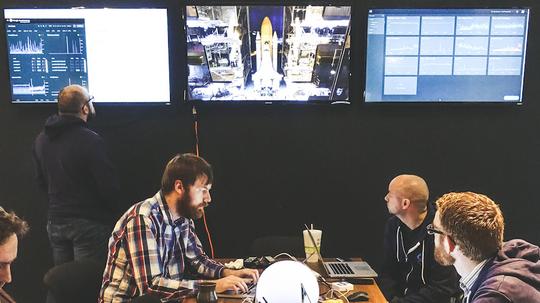
Losant, an Internet of Things platform, has a simple goal: using IoT to make building connected solutions from real-time data collection simple.
Consider its most recent project at the Cincinnati/Northern Kentucky International Airport, where the startup worked with officials to create a smarter sign system for its terminal train.
Using sensor technology that tracks the vehicle, these signs will tell users where the train is, how long before it arrives and other pertinent information. These updated signs look to remedy some travelers' confusion about the train's status and destination in a more straightforward way, and Losant's pitch to make it happen was so attractive, it won the first Request for Proposal from the CVG airport.
"It’s all about gaining data from never-before-seen information."
These kinds of jobs fuel the Losant team, which developed the startup as a sort of passion project in 2015.
Co-founders Brandon Cannaday, Michael Kuehl and Charlie Key initially got the idea after receiving many inquiries from customers at their previous startup, Modulus. These clients wanted to know if the platform could work for the new wave of IoT solutions. However, Modulus — a platform for developing, scaling and motoring Node.js applications — wasn’t ideal for that kind of work.
Yet enough customers continued asking the team about IoT work that the trio began to think about what that kind of platform could be. Eventually, they sat down with customers to dialogue about the types of solutions they were in the market for and how an IoT technology provider could best serve them.
This information helped develop what would become the Losant platform, which essentially helps accelerate the development for connected devices or experiences coming online.
“It’s all about gaining data from never-before-seen information," Cannaday said. "There’s so many things out there in the world that generate very useful information, but it never goes anywhere. By getting these things connected to the internet, and being able to extract that information and pull it somewhere central and be able to act on it, it can lead to some very insightful pieces of knowledge that can then lead to cost-savings and even new revenue streams.”
With the platform, Hewlett-Packard Enterprise has built smart conference rooms, which eliminate the need to waste time setting technology up for a meeting. Instead, sensors and a mobile app automatically turn on computers and connect remote attendants once the organizer walks into the room.
Verizon, too, has employed Losant's technology as it builds and takes to market a condition-based maintenance solution. Condition-based maintenance solutions have large pieces of equipment that can send alerts when they need to be worked on, rather than requiring companies to regularly performing maintenance that may not be needed. Stretching the period in between tune-ups helps companies reduce operational cost significantly, especially if equipment is remote or hard to reach.
These are just two examples of Losant's customer base, many of which are in the industrial IoT sector and who have reacted well to the startups' offerings.
Losant's growth, however, didn't occur in a vacuum. Beyond working with these large corporate customers and being a part of the global IoT accelerator Techstars, Cannaday said the timing of Losant’s launch also helped the organization grow quickly.
“Any startup is a gamble on if you’re going to time the market appropriately,” he said. “What happened was, IoT started to figure out where real value was, and these companies started to come to us about problems they thought IoT could solve and our technology could accelerate.”
Losant continues to keep its eye on external growth, while developing its platform to include tools and features that help keep its customers connected in a meaningful way.
Being based in Cincinnati helps with this mission, as Cannaday said the Midwest is where most of the investment in industrial IoT is happening.
“The Midwest is the hub of those major industries,” he said. “On the other side, the amount of money it takes to create goes a lot farther in the Midwest compared with the coasts. You can raise a fairly good round of funding here, it’s going to get you a better office space, the developers and talent you get is equal to the talent you’ll get anywhere else, but they’re not going to cost as much.”








